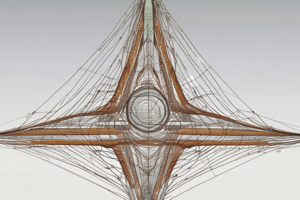Podcast
Questions and Answers
What is the primary strategy for simplifying expressions involving the multiplication of surds, such as $(\sqrt{a} \times \sqrt{b})^2$?
What is the primary strategy for simplifying expressions involving the multiplication of surds, such as $(\sqrt{a} \times \sqrt{b})^2$?
- Directly compute $a \times b$ without simplifying individual surds first.
- Simplify each surd individually to its simplest form before performing multiplication and squaring. (correct)
- Square the values $a$ and $b$ separately, then multiply them.
- Convert surds to decimal approximations before multiplying.
Why is it beneficial to identify the largest perfect square factor when simplifying a surd?
Why is it beneficial to identify the largest perfect square factor when simplifying a surd?
- It makes the surd irrational.
- It allows immediate extraction of an integer from within the square root, leading to a simpler surd. (correct)
- It ensures that the simplified surd contains the smallest possible integer within the square root.
- It increases the value of the surd, making it easier to work with.
How does squaring a surd expression like $(k\sqrt{m})^2$ affect its components?
How does squaring a surd expression like $(k\sqrt{m})^2$ affect its components?
- Only the integer coefficient $k$ is squared.
- Only the surd part $\sqrt{m}$ is squared.
- The entire expression remains unchanged.
- Both the integer coefficient $k$ and the surd part $\sqrt{m}$ are squared. (correct)
Given the expression $(\sqrt{18} \times \sqrt{8})^2$, which of the following steps is a correct application of surd simplification and multiplication rules?
Given the expression $(\sqrt{18} \times \sqrt{8})^2$, which of the following steps is a correct application of surd simplification and multiplication rules?
If simplifying an expression involves $(a\sqrt{b} \times c\sqrt{d})^2$ and it is known that the result equals $k$, what does this imply about the relationship between $a$, $b$, $c$, $d$, and $k$?
If simplifying an expression involves $(a\sqrt{b} \times c\sqrt{d})^2$ and it is known that the result equals $k$, what does this imply about the relationship between $a$, $b$, $c$, $d$, and $k$?
Flashcards
Simplifying Surds
Simplifying Surds
The process of reducing surds to simplest form by identifying perfect square factors.
√50 Simplification
√50 Simplification
√50 simplifies to 5√2 by finding perfect square factor 25.
√68 Simplification
√68 Simplification
√68 simplifies to 2√17 using the perfect square factor 4.
Multiplication of Surds
Multiplication of Surds
Signup and view all the flashcards
Squaring a Surd
Squaring a Surd
Signup and view all the flashcards
Study Notes
Simplifying Surds
- To simplify the expression, first simplify the individual surds, √50 and √68.
- Both surds can be simplified by finding the largest perfect square factors of 50 and 68.
- √50 = √(25 x 2) = √25 x √2 = 5√2
- √68 = √(4 x 17) = √4 x √17 = 2√17
Multiplication of Surds
- Now substitute the simplified surds into the original expression: (√50 x √68)^2 = (5√2 x 2√17)^2 = (10√(2 x 17))^2 = (10√34)^2
Squaring the Result
- Squaring the resulting surd (10√34): (10√34)^2 = 10^2 x (√34)^2 = 100 x 34 = 3400
Studying That Suits You
Use AI to generate personalized quizzes and flashcards to suit your learning preferences.




